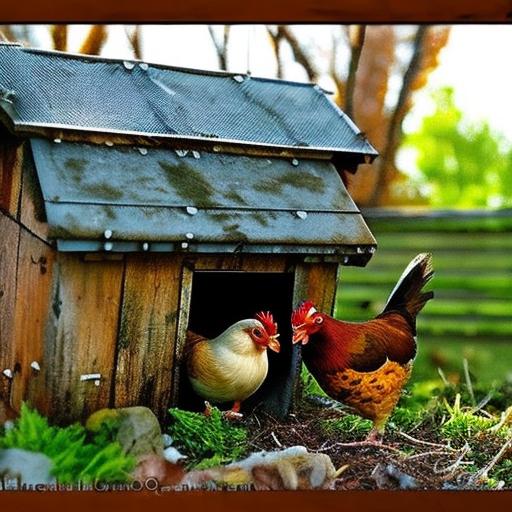Keeping your chickens warm is crucial for their health and well-being. Just like humans, chickens are susceptible to the cold and can suffer from various health issues if not properly protected. Cold temperatures can lead to illness, decreased egg production, and even death. In this blog post, we’ll discuss how to create a cozy coop for your feathered friends, ensuring they stay warm and comfortable throughout the year.
Key Takeaways
- Keeping chickens warm is important for their health and well-being.
- A cozy coop should have proper insulation and ventilation.
- Natural insulation materials like straw and hay can be used in a cozy coop.
- Regular check-ups and repairs are necessary to maintain a cozy coop.
- Proper ventilation and the use of solar power can benefit a cozy coop.
Understanding the Anatomy of a Cozy Coop
A cozy coop should be well-insulated and draft-free. Insulation is essential for trapping heat inside the coop and preventing cold air from seeping in. The walls and roof of the coop should be made of thick, sturdy materials like wood or metal to provide adequate insulation. Additionally, it’s important to seal any cracks or holes in the coop to prevent drafts.
Proper ventilation is also crucial in a cozy coop. While insulation keeps the heat inside, ventilation allows for fresh air circulation and prevents moisture buildup. Moisture can lead to dampness and mold, which can be harmful to your chickens’ health. Install windows and vents in strategic locations to ensure proper airflow without creating drafts.
Natural Insulation Materials for Cozy Coops
When it comes to insulation materials for your coop, natural options are often the best choice. Straw, hay, and wood shavings are excellent natural insulation materials that provide warmth and comfort for your chickens. These materials trap heat and create a cozy environment inside the coop.
Avoid using materials like newspaper or cardboard as they don’t provide adequate insulation. They may also become damp easily, leading to moisture buildup and potential health issues for your chickens.
Building a Cozy Coop: Tips and Tricks
| Tip/Trick | Description |
|---|---|
| Location | Choose a spot that is well-drained and has good ventilation. |
| Size | Provide at least 4 square feet of space per chicken. |
| Nesting Boxes | Provide one nesting box for every 3-4 chickens. |
| Roosting Bars | Provide at least 8 inches of roosting space per chicken. |
| Lighting | Provide 14-16 hours of light per day for maximum egg production. |
| Feed and Water | Provide fresh water and a balanced diet of chicken feed. |
| Cleanliness | Clean the coop regularly to prevent disease and pests. |
When building a cozy coop, there are several tips and tricks you can follow to ensure its effectiveness in keeping your chickens warm. As mentioned earlier, use thick, sturdy materials like wood or metal for the walls and roof. These materials provide better insulation than thinner options.
Install windows and vents to allow for proper ventilation. Windows can be opened or closed depending on the weather conditions, while vents should be strategically placed to allow fresh air to circulate without creating drafts. It’s also important to raise the coop off the ground to prevent moisture buildup.
Maintaining a Cozy Coop: Regular Check-Ups and Repairs
Regularly inspecting your coop for any damage or wear and tear is essential in maintaining its coziness. Check for any holes or cracks that may have developed over time and repair them promptly to prevent drafts. A well-maintained coop will provide better insulation and keep your chickens warm and comfortable.
Keeping the coop clean and dry is also crucial in preventing moisture buildup. Remove any wet bedding or droppings regularly and replace them with fresh, dry materials. This will help maintain a healthy environment for your chickens and prevent any potential health issues.
The Role of Proper Ventilation in Cozy Coops

Proper ventilation is crucial in a cozy coop as it helps prevent moisture buildup and maintains air quality. Without proper ventilation, the coop can become damp, leading to mold growth and respiratory issues for your chickens.
Install windows that can be opened or closed depending on the weather conditions. This allows you to control the airflow inside the coop. Additionally, strategically placed vents will ensure fresh air circulation without creating drafts.
It’s important not to seal the coop too tightly, as this can lead to poor air quality. While you want to keep the cold air out, you also need to ensure there is enough fresh air circulating inside the coop.
The Benefits of Using Solar Power in Cozy Coops
Solar power can be a great way to provide heat and light for your chickens while being environmentally friendly. By installing solar panels or a solar-powered heater in your coop, you can harness the power of the sun to keep your chickens warm and comfortable.
Using solar power in your coop can also save you money on energy costs. Solar panels can generate electricity to power heaters, lights, and other necessary equipment, reducing your reliance on traditional energy sources.
Winterizing Your Cozy Coop: Preparing for Cold Weather
Winterizing your cozy coop is essential to ensure your chickens stay warm during the colder months. Adding extra insulation to the walls and roof will help trap heat inside the coop. You can use materials like straw or hay to provide additional insulation.
Using a heated waterer is also important to prevent the water from freezing. Chickens need access to fresh water at all times, and a frozen waterer can be detrimental to their health. Heated waterers are designed to keep the water at a temperature that prevents freezing.
In extremely cold temperatures, you may need to add a heat lamp or other source of heat inside the coop. This will provide additional warmth for your chickens and help them stay comfortable during harsh winter conditions.
Cozy Coop Accessories: Nesting Boxes, Perches, and More
In addition to insulation and ventilation, there are other accessories you can add to your cozy coop to make it more comfortable for your chickens. Nesting boxes provide a comfortable place for your chickens to lay their eggs. They should be filled with soft bedding material like straw or wood shavings.
Perches allow your chickens to roost and sleep comfortably. They should be placed at varying heights to accommodate different sizes of chickens. Other accessories like feeders and waterers should also be provided to ensure your chickens have easy access to food and water.
Happy Chickens, Happy Life!
Keeping your chickens warm and comfortable is crucial for their health and happiness. By following the tips and tricks in this blog post, you can create a cozy coop that your feathered friends will love. Remember, happy chickens lead to happy owners! So invest the time and effort into creating a cozy coop for your chickens, and you’ll be rewarded with healthy, productive, and contented birds.
If you’re looking for ways to keep your chickens warm without electricity, you might also be interested in learning about the best kind of coop for chickens. Poultry Wizard has a helpful article on “What Kind of Coop is Best for Chickens?” that provides valuable insights into choosing the right coop design and features to ensure your chickens’ comfort and safety. Check it out here.
FAQs
What are the best ways to keep chickens warm without electricity?
There are several ways to keep chickens warm without electricity, including insulating the coop, using deep litter, providing warm bedding, and using a solar-powered heater.
How can I insulate my chicken coop?
You can insulate your chicken coop by using materials such as straw bales, foam board insulation, or reflective insulation. You can also use weatherstripping to seal any gaps or cracks in the coop.
What is deep litter?
Deep litter is a method of keeping chickens warm by adding layers of organic material, such as straw or wood shavings, to the floor of the coop. As the material decomposes, it generates heat, which helps to keep the chickens warm.
What kind of bedding should I use to keep my chickens warm?
You can use a variety of bedding materials to keep your chickens warm, including straw, wood shavings, or shredded paper. Make sure to change the bedding regularly to keep it clean and dry.
Can I use a solar-powered heater to keep my chickens warm?
Yes, you can use a solar-powered heater to keep your chickens warm. These heaters use solar panels to generate electricity, which is then used to power a heating element. They are a great option for those who want to keep their chickens warm without using electricity from the grid.
Meet Walter, the feathered-friend fanatic of Florida! Nestled in the sunshine state, Walter struts through life with his feathered companions, clucking his way to happiness. With a coop that’s fancier than a five-star hotel, he’s the Don Juan of the chicken world. When he’s not teaching his hens to do the cha-cha, you’ll find him in a heated debate with his prized rooster, Sir Clucks-a-Lot. Walter’s poultry passion is no yolk; he’s the sunny-side-up guy you never knew you needed in your flock of friends!







